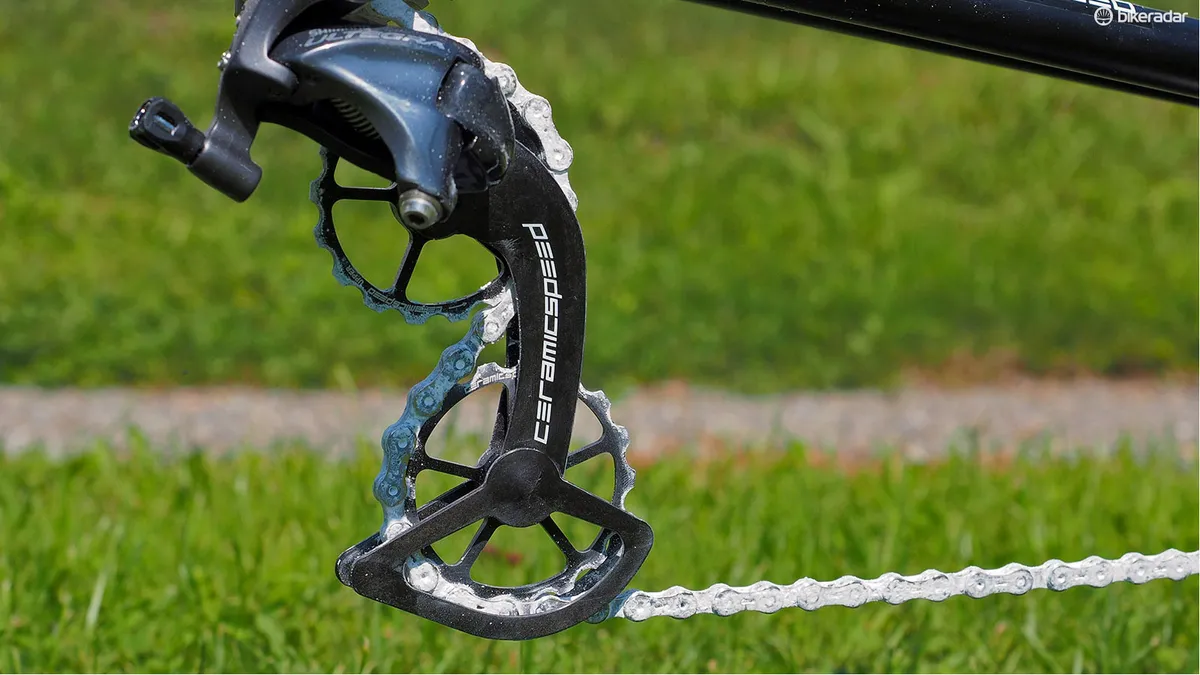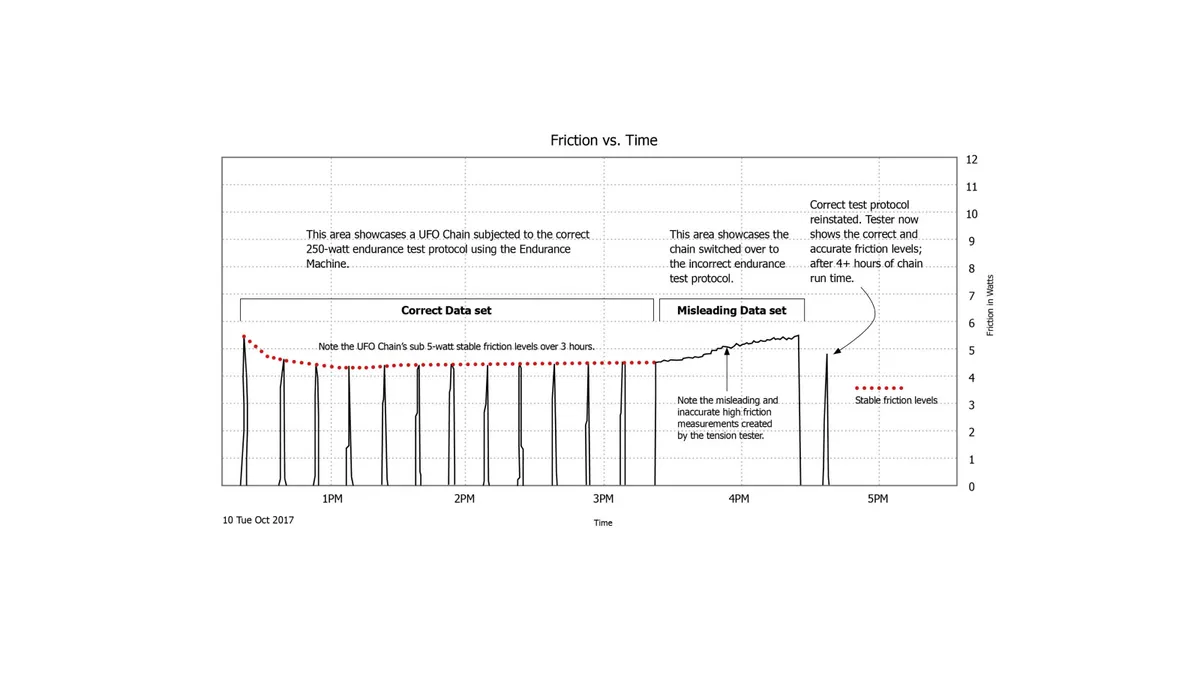Earlier this month Muc-Off released its latest ultra-low friction Nano Tube Chain, which the brand claims can save up to 10 watts over similar products, including CeramicSpeeds' UFO chain.
- CeramicSpeed acquires Friction Facts
- Muc-Off’s fastest chain just got cheaper, but there's a catch...
- Everything you ever wanted to know about cleaning your bike chain
The claim
According to Muc-Off's testing, over a four-hour endurance test the similar UFO chain displayed a gradual friction build up and eventually resulted in a 10-watt difference between the Nano Tube Chain and the UFO. Meanwhile, the same testing showed Muc-Off's chain demonstrating no such build up.
In a seven-page document, Jason Smith, the founder of Friction Facts (which was acquired by CeramicSpeed last year) said that Muc-Off’s claims surrounding the Nano Tube Chain were based on a faulting testing protocol.
Smith believes this claim is misleading and is the result of Muc-Off’s testing procedure, and its protocol fails to account for the ‘Slacking Effect'.
“Based on the test results Muc-Off presented, we must assume that they performed the ‘endurance tests’ with their tester in “Full Tension” mode," Smith says.
“While this mode provides the most precise measurement of friction in a chain, it is designed to be used only for short-term friction measurements. The 'Full Tension' mode should never be used for long-term endurance testing,” he continued.

According to Smith, the reason the full tension test is not the best way to accurately determine how much friction a chain generates over a period of time is because it does not mimic a bicycle drivetrain.
“The Full Tension Tester measures chain friction by applying high levels of tension symmetrically on two chain spans. Rear derailleur chain spans are not present on a Full Tension Tester,” Smith says.
“Simply put, the Full Tension Tester was designed for short-term, high-precision friction measurements. To perform proper endurance testing of a chain, the chain should be tested on Full Tension Tester for an initial friction measurement, then swapped and long-term tested on a rig that is set up to represent a bicycle drivetrain, with true drive power at the ring, load on the cog, and a rear derailleur setup, such as an Endurance Machine, or even an actual bicycle,” he continued.
The slacking effect

What seems to be at the root of this dispute is what Smith calls ‘the slacking effect.’ Discovered in 2015 by Friction Facts, during long test periods of the Full Tension Tester, Smith noticed anomalies while testing certain lubes that would manifest as gradual increases in friction.
“During testing of a chain experiencing this abnormal increase in friction on the Full Tension Tester, the chain friction would instantly drop back down to a normal level, yet slowly creep up again over time, if the load was removed for a few seconds, with the equipment still turning (i.e. the chain was slacked), and the load then re-applied,” Smith said.
“This phenomenon could easily be repeated many times during a single long-term test run, quickly lifting and re-applying the load to slack the chain and the friction levels would return to normal.”
According to Smith, in the real world when your chain snakes its way through the jockey wheels on the rear derailleur it slackens and allows the lubricants to redistribute into the nooks and crannies of the sliding surfaces.
It was this discovery that lead Friction Facts to develop an entirely new testing protocol that incorporated both the Full Tension Tester and an Endurance Machine for ultimate accuracy.
The dispute

When Muc-Off first released a friction vs. time graph that compared the Nano Tube Chain versus the UFO chain, tested a day apart, there was a noticeable difference in the results. According to Smith this is a tell-tale sign that the Full Tension Tester was used to conduct the long-term test.
To support his point Smith conducted a four-hour test of the CeramicSpeed chain using the Friction Facts protocol: three hours with the chain run under 250W on the Endurance machine, with the chain removed and run on the Full Tension machine for one minute at 15-minute intervals.
For the final hour the UFO chain was placed on the Full Tension Tester, which according to the graphs presented by Smith showed a similarly steady increase in friction as presented by Muc-Off.
“After an hour of the incorrect procedure, the chain was removed from the Full Tension Tester and placed back on the Endurance Machine for 10 minutes, to allow the chain to slack through the rear derailleur spans, and then a final friction reading was taken on the Full Tension Tester. The final friction reading was 4.75W,” Smith said.

What to make of all this?
It’s important to reiterate that Friction Facts was acquired by CeramicSpeed and thereby Smith works for the brand. However, it is equally important to note that Smith’s testing protocol was developed long before he had any association the Danish brand, and he has long been the authority when it comes to friction testing. For transparency's sake, Smith’s chain testing protocol is publicly available.
Smith has brought up some interesting points with this paper, though he doesn’t directly compare the chains performance he believes Muc-Off's claims about the UFO chain are based on faulty testing procedures.
Given Smith was able to explain and replicate a similar result to Muc-Off’s claim using testing protocol that's believed to be inaccurate, he makes an interesting case and has data to back it up. Having said that, we don't actually know what Muc-Off's testing procedure entails.
You can read Smith's full paper here and also take a look at Muc-Off's literature here.
We've contacted Muc-Off in the course of writing this article and the brand is aware of Smith's claims. Muc-Off's UK representative Jason Bradwell said that it's being looked into and they'll have a more detailed response in due course. We'll update this article when that happens.
What do you think? Let us know in the comments.
